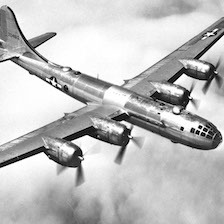The story of the Boeing B-29 Superfortress can be found on many pages on the internet by using one of the many search engines. A key point to be made is there were three models of the B-29 flown by the 5 wings of the XXI Bomber Command. Another variant was the B-29 flown by the 509th Composite Group and still another variant, the F-13, by the 3rd Photo Reconnaissance Squadron.
First there was the B-29. This airplane was the most common of all the B-29s built. These aircraft were built in factories operated by Boeing Aircraft, Wichita, Kansas; Martin Aircraft in Omaha, Nebraska; and Bell Aircraft, Marietta Georgia. Originally, it had four remotely controlled gun turrets on the fuselage each containing two .50 caliber machine guns and a tail gun installation of two .50 caliber machine guns plus a 20mm cannon. There were eleven crew members on the airplane, the Aircraft Commander, Pilot, Bombardier, Navigator, Flight Engineer, Radio Operator, RADAR Operator, Central Fire Control Gunner, two Waist Gunners (left and right), and a Tail Gunner. The airplane was equipped with the AN/APQ-13 RADAR for bombing and navigation. Later, the 20mm cannon was removed from the tail and two additional .50 caliber machine guns were placed in the upper forward turret.
Boeing also built the B-29, A model, in its plant in Renton, Washington. The equipment listed above was retained, the difference between the B-29 and B-29A was in the fuselage wing box. This change also decreased the total fuel load available in the B-29 due to the smaller fuselage fuel tank.
The B-29, B Model, was built by Bell Atlanta in their plant in Marietta Georgia. As the planes came down the assembly line, a total of 311 of them were built to the B-29B version while the remaining continued as a B-29. Four key differences were notable in the B model. First was the fuselage turrets were eliminated. Secondly, the common blister waist gunner windows were replaced with a smaller flat window and the CFC gunner dome was faired over. The AN/APQ-13 RADAR dome was replaced by a 16 foot wing like wave guide antenna mounted between the bomb bays that fed an AN/APQ-7 RADAR, nicknamed, The Eagle. A fourth difference was in the tail gun area where a ball shaped RADAR radome was added for the AN/APG-15 gunnery RADAR. The APG-15 was designed for the gunner to lock his RADAR on his target and the guns followed that target. When in range, the gunner then fired the guns. The system was plagued with problems but the concept was sound, that was the basis for the gunnery RADARs on the B-47 and B-52.
The B-29s flown by the 509th Composite Group, 393rd Bomb Squadron started off on the assembly line as the standard B-29. Several aircraft were selected as they went down the line for the 509th. These aircraft were given the project name of Silverplate. Modifications to the airplanes included the removal of the fuselage guns, enlarging the bomb bays, and engine changes that included fuel injection and adding a reversible pitch propeller system.
The 3rd Photo Reconnaissance Squadron flew a modified version of the B-29 called the F-13. The modifications were to add ports for the photographic equipment. The armament on the F-13 was the same as the B-29.
